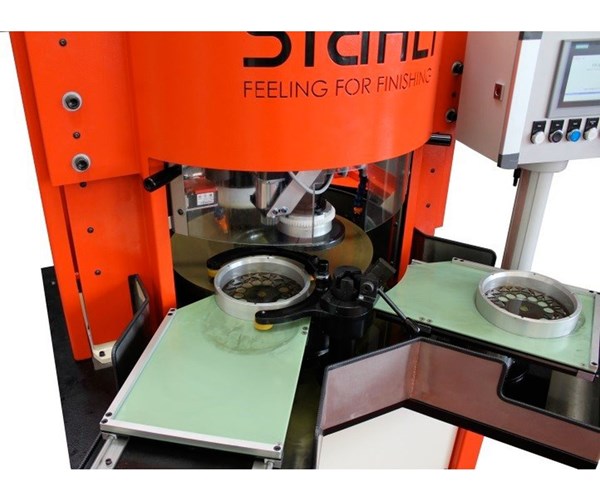Flat Honing Advances with In-Process Measurement
Single-sided machining with a grinding wheel now offers a more productive alternative to single-sided lapping and polishing processes. The key is an in-process measurement system that enables a flat honing machine to adjust wheel pressure automatically for consistent results.

The FH-602 flat honing machine from Stahli can be automated to exchange carrier rings for continuous production.
Historically, single-sided abrasive machining was performed by lapping and polishing because fresh abrasive materials, such as silicon carbide, aluminum oxide or diamond, could be added while keeping the grinding pressure fixed. This approach enabled the process to create a consistent stock removal rate. According to Matt Huff and Timon Reamy, both part of the Stahli Lapping Technologies team (Lake Zurich, Illinois), single-sided abrasive machining with a grinding wheel now offers a more productive alternative.
They explain that flat honing (fine grinding) with planetary kinematics using cubic boron nitride (cBN) or diamond wheels is practical if variable pressure can be applied to adjust for dulling of the grinding wheel. Without means for this adjustment, a flat-honing machine cannot be operated solely by setting the grinding cycle time, because the stock removal rate will vary between grinding wheel sharpening intervals. Therefore, an in-process measurement system is needed so the machine control unit can increase pressure on the parts to compensate for a decline in the stock removal rate. By varying pressure, the grinding wheel can be held at the optimal sharpness point. This approach enables the wheel to be self-sharpening, thus minimizing the rate at which the wheel becomes dull. The newly released Stahli FH-602 machine now provides the necessary highly precise, highly accurate in-process measuring system for this process, the men say.
They add that Stahli Lapping Technologies offers grinding processes on the FH-602 series that are similar to the company’s larger DLM series of production machines. This development enables customers to run demanding and delicate operations on the machine. Depending on stock removal and surface finish requirements, as well as the consumables used, consistent results for 30 to 100 consecutive runs without any sharpening are achievable, they say.
The FH-602 machine uses an automatic size control system from SPS Industries (Farmington, Connecticut) with a touchscreen for entering and adjusting the process parameters. The grinding routine can be defined in multiple steps in which grinding force or removal rate can be controlled with freely selectable wheel turning speeds. The pressure head unit, which was developed and optimized over multiple generations, is one of the most important parts of the system, Mr. Huff and Mr. Reamy point out. It contains the micron-precise in-process system that measures the part thickness between the pressure plate and the grinding wheel. It also houses the stepless drive motor for the ring and pressure plate. Various hard and soft pressure plates are available to accommodate different workpiece materials.
Each batch of parts is placed in a carrier disc, which holds the parts in place inside the loading ring. One ring with a loaded carrier disc is ground at a time, while another ring can be prepared outside the machine. Rings of finished and unfinished parts can be exchanged manually or automatically, depending on how the module design of the machine is configured. Versions of the machine are available with fully covered stations for manual loading as well as stripped machines for integration in an automated cell.
According to Mr. Huff and Mr. Reamy, another important feature of the FH-602 series is the automatic sharpening and dressing station. It is positioned in the back of the machine opposite the grinding station. After a certain number of cycles or when a defined grinding time per cycle is reached, a sharpening and flushing sequence can be initiated manually or automatically. They also note that diamond and cBN grinding wheels can be used for single-sided flat honing with planetary kinematics in conjunction with precise in-process measurement. The efficiency of these superabrasive wheels expands the possibilities for this process and adds new applications within the manufacturing industry.
Related Content
Understanding Swiss-Type Machining
Once seen as a specialty machine tool, the CNC Swiss-type is increasingly being used in shops that are full of more conventional CNC machines. For the newcomer to Swiss-type machining, here is what the learning curve is like.
Read MoreVolumetric Accuracy Is Key to Machining James Webb Telescope
To meet the extreme tolerance of the telescope’s beryllium mirrors, the manufacturer had to rely on stable horizontal machining centers with a high degree of consistency volumetric accuracy.
Read MoreThreading On A Lathe
The right choices in tooling and technique can optimize the thread turning process.
Read MoreChoosing The Right Grinding Wheel
Understanding grinding wheel fundamentals will help you choose the right wheel for the job.
Read MoreRead Next
3 Mistakes That Cause CNC Programs to Fail
Despite enhancements to manufacturing technology, there are still issues today that can cause programs to fail. These failures can cause lost time, scrapped parts, damaged machines and even injured operators.
Read MoreThe Cut Scene: The Finer Details of Large-Format Machining
Small details and features can have an outsized impact on large parts, such as Barbco’s collapsible utility drill head.
Read More


























